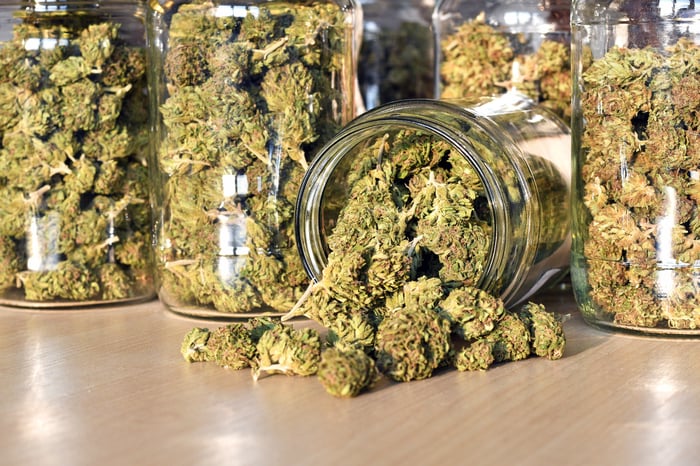A big day is approaching for marijuana stock investors. On Friday, May 29, before the opening bell, Canadian licensed producer Canopy Growth (CGC -0.66%) is set to release its fiscal fourth-quarter and full-year operating results. Being the largest pure-play pot stock by market cap, Canopy's results have a lot of sway within the cannabis industry.
According to Wall Street's consensus estimate, Canopy Growth is expected to deliver $130 million Canadian ($92.9 million U.S.) in sales, representing year-on-year growth of 38%, with a projected loss of CA$0.40 per share, which would be narrower than the CA$0.98 per-share loss in the year-ago period. For what it's worth, Canopy's loss was narrower than expected in the sequential third quarter, but substantially larger-than-expected in each of the three quarters before Q3 2020.
While there's no question that Wall Street and investors will be focused on these top-line numbers, there's going to be much more of interest than just its total sales and loss per share. Here are the five numbers investors should really home in on.

Image source: Getty Images.
1. International sales
Even though Aurora Cannabis has the broadest international presence, no pot stock has been more successful in generating international sales than Canopy Growth. Things really looked to be picking up in the fiscal second quarter (ended Sept. 30, 2019), with CA$18.1 million in overseas sales, but growth slowed to a crawl in the fiscal third quarter, with CA$18.7 million in international revenue. The question is, what can we expect in terms of overseas sales for Q4 2020?
Although international sales only represent in the neighborhood of 15% of total sales, they're a critical piece of the puzzle for long-term growth. Since no other countries aside from Canada or Uruguay have legalized recreational marijuana, it means the overseas markets Canopy is catering to are solely focused on medical-pot patients. And it just so happens to medical patients are typically higher-margin customers than adult-use consumers. Thus, strong overseas growth is imperative to Canopy's long-term success.
2. Share-based compensation
Arguably the biggest crutch over the past year for Canopy Growth has been the company's ballooning expenses. Of course, it's not alone when it comes to rising selling, general and administrative (SG&A) costs, as SG&A expenses have increased for pretty much all licensed producers as their output has expanded. What is unique, though, is Canopy's ridiculously high share-based compensation costs.
Before former co-CEO Bruce Linton was fired in early July 2019, he strongly believed that the best way to encourage employee loyalty and align the company's values with that of its workers was to give long-term-vesting stock to employees. But in doing so, Linton overlooked the reportable costs associated with such a move. Through the first nine months of fiscal 2020, share-based compensation totaled almost CA$218 million.
However, since former Constellation Brands (STZ -0.04%) CFO David Klein took over the CEO post at Canopy Growth in January, he's promised to drastically reduce share-based compensation. Investors should be curious as to what sort of real progress has been made on the cost-cutting front.

Image source: Getty Images.
3. Inventory levels
A third figure of interest is Canopy Growth's inventory levels.
Since the beginning of Canopy's fiscal 2020, on April 1, 2019, and through the end of the 2019 calendar year, the company's inventory levels (expressed in Canadian dollar terms) more than doubled to CA$622.6 million. A healthy backlog of product is certainly a good thing for cannabis companies to have. But what we're seeing in Canopy Growth's case, and with other Canadian licensed producers, is far more production than what's being sold.
Among licensed producers to our north, Canopy Growth has, by far, the biggest inventory problem. That's likely why the company announced the permanent closure of the Aldergrove and Delta greenhouses in March, totaling 3 million square feet. Nevertheless, if we see another quarter of significant inventory growth, the prospect of a writedown will almost certainly have increased.
4. Quarterly cash burn
Among cannabis stocks, Canopy Growth is in a relatively enviable position when it comes to cash on hand. It's received four direct or indirect investments from Constellation Brands, which owns approximately 38.6% of Canopy's outstanding shares, including a $4 billion equity investment that closed in November 2018. As a result, it has the largest cash position of any pure-play pot stock.
However, Canopy Growth's cash burn has been equally atrocious since receiving its record-breaking cash haul from Constellation. Since its fiscal year began, its cash, cash equivalents, and marketable securities have essentially been halved from more than CA$4.5 billion to CA$2.27 billion, at the end of Q3 2020.
What investors will want to pay close attention to is how well David Klein and management reduced Canopy's ongoing cash burn. No one is expecting operating profitability anytime soon, but a sizable drop in operating expenses should, hopefully, have led to less cash burn in the recently ended quarter.

Image source: Getty Images.
5. Goodwill
Finally, investors would be smart to keep a close eye on Canopy Growth's goodwill -- i.e., the premium paid above and beyond a company's tangible and intangible assets when making an acquisition.
Even though Klein has made it pretty clear that his company is done making acquisitions for the time being, it doesn't resolve the fact that Canopy Growth appears to have grossly overpaid for the transactions that were already completed. This is evidenced by the CA$2.07 billion in goodwill it ended the fiscal third quarter with, up from CA$1.54 billion just nine months earlier.
In recent quarters, we've witnessed Aurora Cannabis and HEXO both take sizable writedowns on their goodwill. With Canopy's goodwill totaling 26% of total assets, there's a growing possibility that this could be its fate, as well. Pay close attention to the company's balance sheet and take note of any commentary by management with regard to its goodwill.





